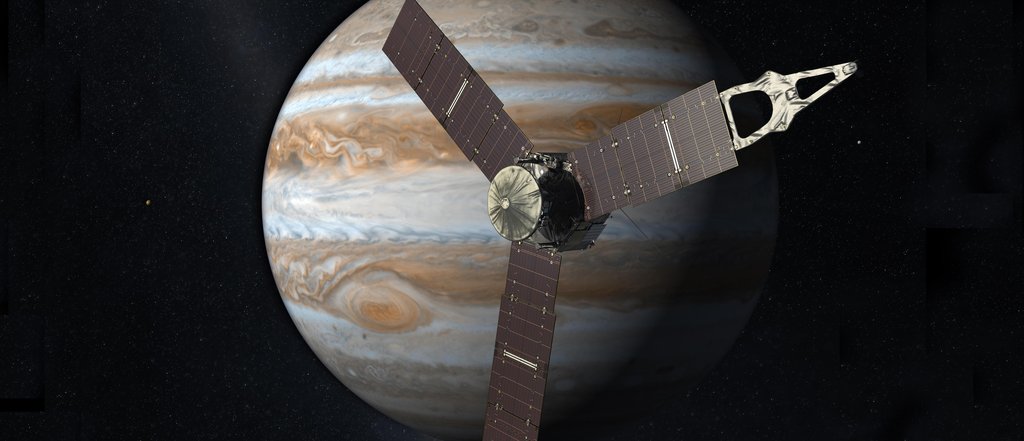Lesson .
.Calculating Solar Power in Space

Overview
Students will explore the practical applications of exponents and division to investigate what it takes for NASA spacecraft to travel deep into the solar system using only solar power.
Materials
- Student Worksheet - Download Docx | View on Google Drive
- Teacher Answer Key - Download Docx | View on Google Drive
- Ruler (capable of measuring out 1 foot increments up to 5 feet)
- Mobile device with light sensor and lux measuring app
- Light source, possibly an LED flashlight or LED light from a mobile device
- Darkened room
Management
- Download the Student Worksheet from the materials list and make copies of both problems in the set or individual problems to hand out to students.
Safety Notes
- This activity takes place in a darkened room, which can pose slip, trip and fall hazards. Keep walking paths clear and minimize unnecessary student movement in the darkened room.
- LED flashlights or light from a mobile device is recommended. If using a non-LED flashlight with the reflector housing removed, take safety measures to avoid accidental burns from a hot bulb.
Background
Different spacecraft have different power needs so some solar-powered spacecraft will have different size solar panels than others. The farther a spacecraft is traveling from the Sun, the larger its solar arrays need to be to meet its specific power needs. That’s because sunlight becomes less intense the farther a spacecraft travels from the Sun, just as a bright source of light dims as you move away from it. Dimmer sunlight limits the amount of power that can be generated using solar cells.
Previous missions that visited Jupiter, like Galileo, Voyager 1 and Voyager 2, couldn’t use solar power and instead used radioisotope thermoelectric generators (RTGs) to supply power. Advances in solar panel efficiency along with improvements in the way spacecraft and their instruments use power have recently made solar power a viable option for spacecraft heading as far as Jupiter – though going beyond will require further technological advances.
One such solar-powered mission is NASA’s Psyche spacecraft, which will visit an asteroid known as 16 Psyche. Located in the asteroid belt between Mars and Jupiter, the 16 Psyche asteroid orbits the Sun at a distance ranging from 378 million to 497 million kilometers (235 million to 309 million miles). That’s 2.5 to 3.3 times the distance between Earth and the Sun. To generate enough power at that distance, the Psyche spacecraft's solar panels are designed to have an area of 75 square meters (800 square feet).
NASA’s Juno mission, the first solar-powered mission to Jupiter, is the farthest solar-powered spacecraft ever. Juno, and its eight science instruments designed to study the interior of Jupiter, passed the mark previously held by the European Space Agency’s Rosetta mission when it reached a distance of 5.3 astronomical units from the Sun. An astronomical unit is equal to the average distance between Earth and the Sun – about 150 million kilometers (93 million miles). To achieve the feat, engineers designed Juno with three massive solar panels, each nearly 9 meters (30 feet) long. Combined, they provide Juno with 50 square meters (535 square feet) of active solar cells.
The Europa Clipper mission will become the second solar-powered spacecraft to orbit Jupiter when it arrives to study the giant planet’s ice-covered moon Europa. To meet its power needs, the spacecraft is equipped with solar arrays covering an area of over 90 square meters (960 square feet).
Understanding how much sunlight a spacecraft is receiving, and by extension how much energy the solar panels can generate at any point on its journey is as simple as understanding division and exponents. We use these math concepts to describe a relationship between Earth, the Sun and the spacecraft using the inverse square law. We express this law as: 1/d2, where d equals the distance between the spacecraft and the Sun as compared to Earth’s distance from the Sun.
Let’s start at home. Earth’s orbit is not a perfect circle, but an ellipse that brings Earth as close as 147 million kilometers (91.4 million miles) from the Sun and as far as 152 million kilometers (94.5 million miles) from the Sun. To make the math a little easier, astronomers define the average distance between Earth and the Sun as one astronomical unit (AU). For our problem, astronomical units will be our measure of distance.
Knowing that Juno became the farthest solar powered spacecraft when it was 5.3 AU from the sun allows us to use the inverse square law to calculate how much sunlight is received at that distance. Substituting 5.3 AU for d gives us 1/5.32, or 0.036 – this tells us that at this distance, only 3.6 percent of the solar energy received at Earth is reaching Juno.
But just how much energy is that? In order to answer that question, we need to know how much energy is coming from the sun. The total solar irradiance (TSI) is a measure of the average amount of solar energy that reaches the top of Earth’s atmosphere. It was recorded by the SORCE satellite to be 1360.8 w/m2. So at 1 AU, Juno’s solar panels would receive 1360.8 w/m2. Taking 3.6 percent gives us 48.99 w/m2. With 49.7 m2 of active cells, there is a great deal of energy falling on the solar panels. Of course, even with improved technology, solar panels are not 100 percent efficient, which is why the spacecraft doesn’t convert all the energy it receives into usable power.
Procedures
Start with a dark classroom. The darker the better, as any stray light will affect the lux reading and change your results.
Safety reminder! Dark rooms can pose a slip, trip and fall hazard. Keep walking paths clear and minimize unnecessary student movement in the darkened room.
Stand the device upright as close to vertical as you can with the light sensor (typically on the front) facing the light source. You may need to brace it with books to keep it perpendicular to the surface.
Place the light source one foot away and record the lux reading. Readings will vary depending on how bright the light source is that you are using. If you have a second mobile device with an LED light, that can be used as a light source pointing toward the first device with the lux meter app.
Safety reminder! LEDs from mobile devices provide an even output of very low temperature light compared to flashlights with incandescent bulbs and reflectors. If you use a flashlight and have removed the reflector housing to create an even light source, the exposed bulb can become very hot. Take safety measures to avoid accidental burns from a hot bulb. LED flashlights are much cooler and minimize the risk of burns.
Move the light source an additional foot away. Because the distance is doubled from our first measurement, the inverse square law shows that the lux measurement should be 1/4 that of the first measurement. Have students check to see if the measurement matches their prediction. Because there may be stray light reaching the light sensor, the measurement may not be exactly 1/4 of the first measurement. Again, the darker the room, the better.
Continue recording light measurements at the three, four and five foot marks, comparing measurements to predictions.
Assessment
In addition to checking for accuracy on the student worksheet, assess students' ability to apply what they have learned to other locations in the solar system by asking them to calculate the percent of energy received at the following locations:
- Asteroid 16 Psyche (min.): 2.5 AU
- Asteroid 16 Psyche (max.): 3.3 AU
- Saturn: 9.54 AU
- Uranus: 19.18 AU
- Neptune: 30.06 AU
- Pluto (min.): 29.69 AU
- Pluto (avg.): 39.44 AU
- Pluto (max.): 49.19 AU
Pluto's highly eccentric orbit causes the dwarf planet to cross the orbital path of Neptune and be closer to the sun than Neptune at certain points in its orbit.
Extensions
- Juno mission website - News, resources and updates on NASA's mission to Jupiter.
- Eyes on the Solar System - Take a virtual journey to Jupiter with Juno (scroll to "Solar System Tours" and click on Juno).
- To Jupiter with JunoCam! - Find out how classrooms can participate in the Juno mission to Jupiter using the spacecraft's on-board educational camera.
- Infographic: Solar Power Explorers - This graphic shows how NASA’s Juno mission to Jupiter became the most distant solar-powered explorer and influenced the future of space exploration powered by the sun.
- Cruising to Jupiter: A Powerful Math Lesson - Teachable Moment article for teachers.
About the Author

Lyle Tavernier
Educational Technology Specialist, NASA-JPL Education Office
Lesson Last Updated: Oct. 21, 2024


